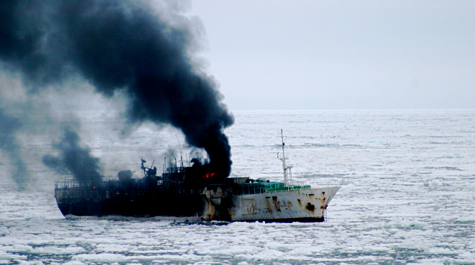VIMS team assists in Antarctic maritime rescue
Professor Walker Smith of the Virginia Institute of Marine Science and his research team, conducting marine studies aboard the research vessel Nathaniel B. Palmer in Antarctica’s Ross Sea, were involved in the rescue of seven injured fishermen from a stricken South Korean vessel, which caught fire in the early hours of Wednesday, January 11.
The 167-foot fishing vessel Jeong Woo 2 caught fire about 370 miles north-northeast of the U.S. Antarctic McMurdo Research Base and 2,000 miles south of Christchurch, New Zealand. Maritime New Zealand, similar to the U.S. Coast Guard, reports that the fire killed three crewmen. Thirty uninjured survivors were transferred to the stricken vessel’s sister ship, the Jeong Woo 3, which will bring them to the Korean icebreaker Araon for transport to Lyttleton, New Zealand.
The Associated Press reports that the vessel is owned by the Sunwoo Corporation and is licensed to fish for crab, Patagonian toothfish (marketed as Chilean sea bass), and other bottom-dwelling fish.
Several ships were in the vicinity of the Jeong Woo 2 when it caught fire. The 308-foot Palmer—the largest and best equipped medically—was chosen to pick up the 7 injured crew for transport to medical facilities at McMurdo, which is the closest port. The transit was expected to take about 24 hours depending on ice conditions.
Smith—who leads a VIMS contingent aboard the Palmer that includes graduate students Sean Charles and Anna Mosby, marine technician Liza Delizo, and Vietnamese collaborator Dr. Hai Doan—says the injured were mostly Vietnamese. “It’s fortunate that Hai is from Vietnam and could help in translating what was happening and would happen,” said Smith in an e-mail. “He has been with his countrymen constantly since they transferred the injured crew to the ship."
Smith says that calm weather also helped with the rescue. “The transfer of the injured crewmen was helped by the incredibly calm seas. It might have been problematic in worse conditions.” The rescue was made at ~73°S, in an area often tossed by wind-driven waves. Water temperature at the time of the rescue was -0.2°C (31.6°F).
Transfer of the injured fishermen and provision of medical services aboard the Palmer were provided by Palmer crewmembers, employees of the Raytheon Polar Services Company (RPSC). The United States Antarctic Program, part of the National Science Foundation’s Office of Polar Programs, contracts with RPSC for all its non-science operations. The crew transferred the injured fishermen to the Palmer aboard small inflatable Zodiacs.
Smith reports that “Two of the injured men suffered second and third degree burns on their feet, face, and hands, and those two are by far the more seriously injured of the seven brought onboard.” The injured are listed as stable.
Science
“Everyone on the Palmer seems to be dealing with this well,” says Smith, “though there is stress that the science is compromised and time will be lost. But that of course is a secondary concern. We’re hopefully going to be back doing work by tomorrow.”
Smith’s team is aboard the Palmer with colleagues from the Woods Hole Oceanographic Institution and Old Dominion University for a 6-week NSF-funded research expedition to study the role that iron plays in controlling the growth of phytoplankton in the Ross Sea. Smith is an internationally known phytoplankton expert with more than two decades of Antarctic research experience, much of it in the Ross Sea area.
Smith invited Doan aboard the currentPalmer cruise as part of VIMS’ recently signed memorandum of understanding with the Institute of Oceanography (ION) in Nha Trang, Vietnam, Doan’s home institution. Doan, leader of Plankton Ecology group at ION, is helping to identify the phytoplankton species encountered on thePalmer cruise.
The phytoplankton species collected on the cruise so far have been dominated by the colony-forming species Phaeocystis antarctica. Phaeocystis, which can form blooms large enough to be seen from space, can be a dominant species in some parts of the Southern Ocean around Antarctica and is important in the cycling of nutrients and carbon in polar waters. It is a focus of Smith’s current research, both in Antarctica and southeast Asia.
Latest Updates from Maritime New Zealand
13 January 2012 - 7.00AM
- The USAF C-17 Globemaster III aircraft was unable to make its scheduled flight from Christchurch to McMurdo Base overnight because of weather conditions at the destination.
- The Nathaniel B. Palmer carrying the injured crew has arrived at McMurdo, and the injured crew are being transferred by helicopter to the base. They will be flown to Christchurch this afternoon (leaving approximately 12.15pm NZDT) on a special flight using a C-130 which was already at McMurdo. The flight is expected to arrive at Christchurch at around 8pm NZDT.
13 January 2012 - 2.00PM
A United States Airforce (USAF) C-130 Hercules aircraft departed McMurdo station at 12.35pm today (NZDT) with the 7 injured crew on board. Three of the men are seriously injured.
- The aircraft’s ETA in Christchurch is 8.45pm this evening (NZDT).
- The injured crew will be taken to Christchurch hospital on arrival for assessment and further treatment as required.
















